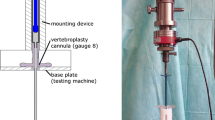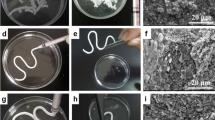Abstract
Purpose
Calcium phosphate cement (CPC) is a potentially useful alternative to polymethylmethacrylate (PMMA) for transpedicular injection into osteoporotic vertebral fractures. Unlike PMMA, CPC is both biocompatible and osteoconductive without producing heat from polymerization, but it has lower compressive strength compared to PMMA. This in vitro model experiment analyzed how different CPC powder–liquid ratios (P/L ratios) and injection methods may minimize blood contamination in the CPC and, thereby its reduction in compressive strength.
Methods
(1) CPC of different P/L ratios of 4.0, 3.5, and 3.2 was equally mixed with different amounts of freshly obtained human venous blood, producing cylindrically shaped CPC samples. (2) Using a transpedicular vertebroplasty model containing blood in the bottom, CPC pastes of different P/L ratios were injected with the nozzle of an injection gun affixed either to the bottom (Bottom method) or to the top of the container (Top method). All cylindrical CPC samples thus obtained were immersed in simulated body fluid and then underwent compressive strength tests at 3 h–7 days post-immersion.
Results
In CPC equally mixed with blood, lower P/L ratios and a larger amount of blood contamination reduced compressive strength more significantly. Of the two methods of CPC injection, the ‘Bottom method’ produced significantly greater compressive strength values than the ‘Top method’.
Conclusions
When performing CPC-assisted vertebroplasty, a greater load bearing-support can be obtained by injecting CPC paste of a high P/L ratio of 4.0 into the deepest part of the space inside the vertebral body to minimize blood contamination.





Similar content being viewed by others
References
Barr JD, Barr MS, Lemley TJ, McCann RM (2000) Percutaneous vertebroplasty for pain relief and spinal stabilization. Spine 25:923–928
Garfin SR, Buckley RA, Ledlie J (2006) Balloon kyphoplasty for symptomatic vertebral body compression fractures results in rapid, significant, and sustained improvements in back pain, function, and quality of life for elderly patients. Spine 31:2213–2220
Lieberman IH, Dudeney S, Reinhardt MK, Bell G (2001) Initial outcome and efficacy of “kyphoplasty” in the treatment of painful osteoporotic vertebral compression fracture. Spine 26:1631–1638
Blattert TR, Jestaedt L, Weckbach A (2009) Suitability of a calcium phosphate cement in osteoporotic vertebral body fracture augmentation. Spine 34:108–114
Grafe IA, Baier M, Nöldge G, Weiss C, Da Fonseca K, Hillmeier J, Libicher M, Rudofsky G, Metzner C, Nawroth P, Meeder PJ, Kasperk C (2008) Calcium-phosphate and polymethylmethacrylate in long-term outcome after kyphoplasty of painful osteoporotic vertebral fractures. Spine 33:1284–1290
Nakano M, Hirano N, Zukawa M, Suzuki K, Hirose J, Kimura T, Kawaguchi Y (2012) Vertebroplasty using calcium phosphate cement for osteoporotic vertebral fractures: study of outcomes at a minimum follow-up of two years. Asia Spine J 6:34–42
Takemasa R, Yamamoto H (2002) Transpedicular injection of calcium phosphate cement into the vertebral body for repair of osteoporotic vertebral fracture. Spine Spinal Cord 15:171–178 (in Japanese)
Takemasa R, Yamamoto H (2002) Repair of osteoporotic vertebral compression fracture by transpedicular injection of bioactive calcium phosphate cement into the vertebral body. Spine J 2:96S
Takemasa R, Tani T, Kiyasu K, Yamamoto H (2006) Surgical complications and safety in mini-open transpedicular vertebroplasty using calcium phosphate cement for osteoporotic vertebral fractures. Spine J 6:29S–30S
Belkoff SM, Molloy S (2003) Temperature measurement during polymerization of polymethylmethacrylate cement used for vertebroplasty. Spine 28:1555–1559
Dahl OE, Garvik LJ, Lyberg T (1994) Toxic effects of methylmethacrylate monomer on leukocytes and endothelial cells in vitro. Acta Orthop Scand 65:147–153
Hirano M, Takeuchi H (2003) Development of the calcium phosphate bone cement “BIOPEX”. Biomaterial 21:24–29 (in Japanese)
Galovich LA, Perez-Higueras A, Altonaga JR, Gonzalo Orden JM, Mariñoso Barba ML, Carrascal Morillo MT (2011) Biomechanical, histological and histomorphometric analyses of calcium phosphate cement compared to PMMA for vertebral augmentation in a validated animal model. Eur Spine J 20(Suppl 3):S376–S382
Meyer PR, Lautenschlager EP, Moore BK (1973) On the setting properties of acrylic bone cement. J Bone Joint Surg Am 55:149–156
Yamamoto H, Niwa S, Hori M, Hattori T, Sawai K, Aoki S, Hirano M, Takeuchi H (1998) Mechanical strength of calcium phosphate cement in vivo and in vitro. Biomaterials 19:1587–1591
Kurashina K, Kurita H, Hirano M, de Blieck AJM, Klein CP, de Groot K (1995) Calcium phosphate cement: in vitro and in vivo studies of the α-tricalcium phosphate-dicalcium phosphate dibasic-tetracalcium phosphate monoxide system. J Mater Sci Mater Med 6:340–347
Nouda S, Tomita S, Kin A, Kawahara K, Kinoshita M (2009) Adjacent vertebral body fractures following vertebroplasty with polymethylmethacrylate or calcium phosphate cement. Spine 34:2613–2618
Bai B, Jazrawi LM, Kummer FJ, Spivak JM (1999) The use of an injectable, biodegradable calcium phosphate bone substitute for the prophylactic augmentation of osteoporotic vertebrae and the management of vertebral compression fractures. Spine 24:1521–1526
Ikeuchi M, Yamamoto H, Shibata T, Otani M (2001) Mechanical augmentation of the vertebral body by calcium phosphate cement injection. J Orthop Sci 6:39–45
Khanna AJ, Lee S, Villarraga M, Gimbel J, Steffey D, Schwardt J (2008) Biomechanical evaluation of kyphoplasty with calcium phosphate cement in a 2-functional spinal unit vertebral compression fracture model. Spine J 8:770–777
Seino H, Yamagata M, Takahashi K, Murata Y, Suzuki H, Morita H (2003) Biomechanical study of human cadaveric lumbar spine reinforced by newly developed hydroxyapatite bone cement. J Orthop Sci 8:50–54
Tomita S, Molloy S, Jasper LE, Abe M, Belkoff SM (2004) Biomechanical comparison of kyphoplasty with difference cements. Spine 29:1203–1207
Turner TM, Urban RM, Singh K, Hall DJ, Renner SM, Lim TH, Tomlinson MJ, Howard S (2008) Vertebroplasty comparing injectable calcium phosphate cement compared with polymethylmethacrylate in a unique canine vertebral body large defect model. Spine J 8:482–487
Musha Y, Umeda T, Mizutani K (2006) Experimental study on the effects of blood admixture with calcium phosphate cement. Med Postgrad 44:58–67
Takeuchi H (2002) The material of the bioactive bone paste. Spine Spinal cord 15:1056–1063 (in Japanese)
Acknowledgments
The authors would like to thank Dr. Masahiro Hirano, the inventor of CPC, for his advice and technical assistance, and Mr. Matthew Mclaughlin for his help with translating the manuscript into English.
Conflict of interest
None.
Author information
Authors and Affiliations
Corresponding author
Rights and permissions
About this article
Cite this article
Kiyasu, K., Takemasa, R., Ikeuchi, M. et al. Differential blood contamination levels and powder–liquid ratios can affect the compressive strength of calcium phosphate cement (CPC): a study using a transpedicular vertebroplasty model. Eur Spine J 22, 1643–1649 (2013). https://doi.org/10.1007/s00586-013-2800-y
Received:
Revised:
Accepted:
Published:
Issue Date:
DOI: https://doi.org/10.1007/s00586-013-2800-y




